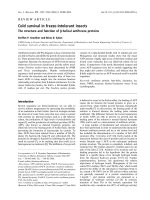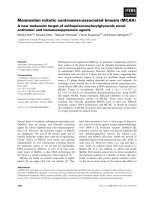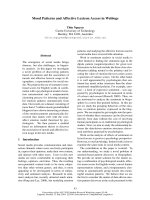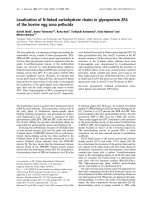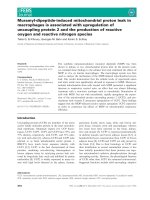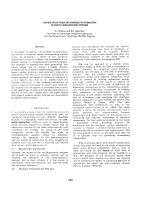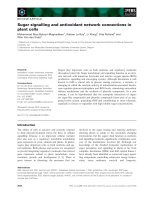Báo cáo khoa học: Cold exposure and associated metabolic changes in adult tropical beetles exposed to fluctuating thermal regimes ppt
Bạn đang xem bản rút gọn của tài liệu. Xem và tải ngay bản đầy đủ của tài liệu tại đây (293.07 KB, 9 trang )
Cold exposure and associated metabolic changes in adult
tropical beetles exposed to fluctuating thermal regimes
L. Lalouette
1
, V. Kos
ˇ
ta
´
l
2
, H. Colinet
3
, D. Gagneul
4,5
and D. Renault
1
1 UMR CNRS 6553, Universite
´
de Rennes 1, Rennes, France
2 Institute of Entomology, Biology Centre AS CR, C
ˇ
eske
´
Budejovice, Czech Republic
3 Unite
´
d’Ecologie et de Bioge
´
ographie, Centre de Recherche sur la Biodiversite
´
, Universite
´
catholique de Louvain, Louvain-la-Neuve,
Belgium
4 UMR CNRS 6026, Universite
´
de Rennes 1, Rennes, France
5 Department of Plant Biology, Michigan State University, East Lansing, MI, USA
Environmental stress deleteriously affects every aspect
of an ectotherm’s biological function because it dis-
rupts homeostasis, and is of sufficient magnitude to
impose geographical limits on where animal life can
occur, even if the other environmental parameters are
permissive [1,2]. As arthropods’ development and sur-
vival are intimately linked to environmental tempera-
tures, these organisms have evolved a diversity of
morphological, physiological and behavioural adapta-
tions [3]. Several authors have contributed to the
increased knowledge of arthropods’ cold-hardiness
over the past years [4–7], but studies were usually per-
formed under controlled conditions by measuring
organisms’ cold-tolerance at low but constant tempera-
tures. Fluctuating thermal regimes (FTRs) are, how-
ever, typical in natural habitats, and yearly active
species may exploit intermittent periods of favourable
temperatures in order to feed, develop and repair low
temperature injuries (chill injuries, i.e. damage caused
by low temperatures without formation of ice crystals).
Keywords
amino acid; fluctuating thermal regime;
insect; polyol; sugar
Correspondence
D. Renault, UMR CNRS 6553, University of
Rennes 1 Ba
ˆ
t. 14A, 263 Avenue du Gal
Leclerc, CS 74205, 35042 Rennes Cedex,
France
Fax: +33 2 23235046
Tel: +33 2 23236627
E-mail:
Website:
(Received 13 November 2006, revised 26
January 2007, accepted 1 February 2007)
doi:10.1111/j.1742-4658.2007.05723.x
Environmental stress deleteriously affects every aspect of an ectotherm’s
biological function. Frequent exposure of terrestrial insects to temperature
variation has thus led to the evolution of protective biochemical and phy-
siological mechanisms. However, the physiological mechanisms underlying
the positive impact of fluctuating thermal regimes (FTRs) on the fitness
and survival of cold-exposed insects have not been studied. We have thus
investigated the metabolic changes in adults of the beetle Alphitobius
diaperinus in order to determine whether FTRs trigger the initiation of a
metabolic response involving synthesis of protective compounds, such as
free amino acids (FAAs) and polyols. The metabolic profile was analyzed
during constant fluctuating thermal regimes (the beetles had daily pulses at
higher temperatures that enabled them to recover) and compared with con-
stant cold exposure and untreated controls. The increase of several essential
amino acids (Lys, Iso, Leu, Phe and Trp) in cold-exposed beetles supports
the conclusion that it results from the breakdown of proteins. Some FAAs
have been shown to have cryoprotective properties in insects, but the rela-
tionship between FAAs, cold tolerance and survival has not yet been well
defined. Instead of considering FAAs only as a part of the osmo- and cryo-
protective arsenal, they should also be regarded as main factors involved in
the multiple regulatory pathways activated during cold acclimation. Under
FTRs, polyol accumulation probably contributes to the increased duration
of survival in A. diaperinus.
Abbreviations
FAA, free amino acid; FM, fresh mass; FTR, fluctuating thermal regime; HSP, heat shock protein.
FEBS Journal 274 (2007) 1759–1767 ª 2007 The Authors Journal compilation ª 2007 FEBS 1759
Such species may also set up physiological processes of
cold-hardening that is cued by the low temperature
but requires a stay at higher temperature for effective
expression [8].
In most species tested to date, survival rates were con-
siderably increased when insects were exposed to FTRs,
compared with those maintained under constant low
temperatures. Indeed, the short bouts at a higher tem-
perature may reset the physiological state of the insects
towards the initial value [6,8–10]. However, few studies
attempted to investigate the physiological and biochemi-
cal responses of insects subjected to thermal fluctua-
tions, and thus the mechanisms underlying the relative
increase of cold tolerance in insects exposed to FTRs
are poorly understood. Recently, Kos
ˇ
ta
´
l et al. [11]
found that constant cold-exposed bugs of Pyrrhocoris
apterus and beetles of Alphitobius diaperinus failed to
maintain specific ion concentrations outside and inside
the cells, or across epithelia. Under FTRs, however, the
primary ion pumping systems, P- and V-type ATPases,
were allowed to re-establish the ion gradients across cell
membranes and epithelia during the ‘warm’ periods [11].
The impaired function of ion pumping systems, together
with the inability to prevent ⁄ restrict ion leakage down
the electrochemical gradient, led to the reduction or
unbalance of metabolites transfer. This then results in
the depletion of energetic substances in cells, or in the
accumulation of potentially toxic waste substances [3].
Thermal stress strongly impacts on metabolite con-
centrations [4,12,13]. Thus, metabolite changes that
occur downstream of changes in transcript or protein
levels give a good picture of the overall integrated
response of an organism [14,15]. The free amino acid
(FAA) pool, which is at the centre of metabolic activity
during a variety of stress responses [16], is particularly
affected by thermal stress, and can thus indicate chan-
ges in gene and protein expression, like heat shock pro-
teins (HSPs). Indeed, it was recently found that FTRs
significantly increase the expression of HSPs during
high temperature pulses [17, L. Lalouette, H. Colinet,
D. Siaussat & D. Renault, unpublished data]. More-
over, several amino acids, like Pro, Gly, Ala, and Leu,
were identified as responsive to cold stress during con-
stant cold exposure [18]. They were either directly corre-
lated with stress tolerance (a causal relationship
between Pro levels and stress tolerance was found
[3,19]), or with the changes in levels of stress hormones
during thermal stress [20]. However, despite their pre-
dominant role in several metabolic pathways, amino
acids were never investigated in insects exposed
to FTRs. Other than amino acids, the importance of
polyols and sugars, like glycerol and trehalose, has
been emphasized regularly during insect cold
acclimation [21]. However, the few studies that have
attempted to investigate polyol levels in insects subjec-
ted to FTRs are contradictory. Indeed, cycling thermal
regimes were found to increase glycerol amounts in the
gall fly [22], whereas it did not differ significantly
between cyclic and constant temperature regimes in the
beet armyworm [23].
In the present study, we investigated the impact of
cold exposure and associated metabolic changes in a
year-round active beetle, A. diaperinus, introduced in
temperate regions from the Ivory Coast (Africa).
A. diaperinus was a convenient model because it is
highly chill-susceptible during cold exposures, but
exhibits strong recovery capacities during the pulses at
a ‘warm’ temperature under FTRs [9]. Contrasted meta-
bolic responses should therefore be obtained between
chilled beetles and ones that were allowed to recover
daily. Moreover, relatively extensive knowledge on the
cold-hardiness ecology and physiology of A. diaperinus
has been gathered [9,11–13,24]: these studies demon-
strated that its survival was progressively reduced when
the temperature dropped below 8 °C. In a more recent
work, we found that beetles kept at a constant tempera-
ture of 0 °C quickly died, whereas the effects of chilling
were reversed completely when insects were kept in
FTRs (5 °C ⁄ 22 h and 20 °C ⁄ 2 h) [9]. Thus, we wanted
to determine whether FTRs trigger the initiation of a
metabolic response involving synthesis of protective
compounds such as FAAs, polyols or HSPs. The simul-
taneous measurement of a large number of metabolites,
relevant because the overall effect of the thermal stress
is assessed [15], was thus investigated in beetles kept
under FTRs, and compared to constant cold-exposed
beetles, and untreated controls.
Results
Survival
Lethal time for 50% of the population (Lt
50
) of the
beetles exposed at constant 0 °C was 5.95 ± 0.65 days.
After 10 days of FTR (0 °C alternating with 20 °Con
a 12 h basis), no mortality was observed. The experi-
ment was stopped after 3 weeks, and it was not possi-
ble to determine the Lt
50
for these beetles. Longer
exposures to such experimental conditions would
encounter mortality unrelated to cold.
Amino acids
Several differences were found in metabolic profiles
between insects exposed to constant temperatures and
fluctuating thermal regimes.
Cold exposure and associated metabolic changes L. Lalouette et al.
1760 FEBS Journal 274 (2007) 1759–1767 ª 2007 The Authors Journal compilation ª 2007 FEBS
The total FAA pool was significantly higher in control
beetles [73.19 ± 2.18 nmolÆmg
)1
fresh mass (FM)]
than in constant cold-exposed (0 °C
c
) (56.72 ± 3.31
nmolÆmg
)1
FM) and 20 °C
F0°
(20 °C/12 hr[20 °C
F0°
]
fluctuating with 0 °C/12 hr[0 °C
F20°
]) ones (51.56 ±
2.35 nmolÆmg
)1
FM) (P<0.05); the total amount of
FAA was significantly higher in 0 °C
F20°
beetles
(72.58 ± 4.58 nmolÆmg
)1
FM) than in 0 °C
c
and
20 °C
F0°
ones (P<0.05).
Pro was the main amino acid found, whatever the
experimental conditions (Fig. 1A,B). It is, however,
interesting to notice that it represented 35% of the
total FAA pool in beetles exposed at a constant tem-
perature of 0 °C, 50% of the total FAA pool at alter-
nating temperature (20 °C
F0°
,0°C
F20°
) (Fig. 1A) and
>50% of the total FAA pool in control beetles. Gln
and Ala were also found in high amounts in the whole
body of A. diaperinus. Levels of five essential amino
acids (Lys, Iso, Leu, Phe and Trp) were increased sig-
nificantly when the beetles were cold exposed
(Fig. 1B). No significant difference was found for Val
between the four distinct thermal treatments (control,
0 °C
c
,0°C
F20°
and 20 °C
F0°
).
Control beetles exhibited the lowest amounts of Glu
and Lys, and the highest levels of Asn ⁄ Ser and
Arg ⁄ Thr (Fig. 1A,B). Gln was significantly lower in
control and 0 °C
c
beetles (P<0.05), whereas an
opposite conclusion was found with Pro (significantly
higher in control and 0 °C
c
beetles).
Amino acid profiles in 0 °C
c
versus 0 ° C
F20°
beetles
The level of several FAA differed between the 0 °C
c
and 0 °C
F20°
thermal treatments. Ala, Gln and Pro
accounted for most of the observed quantitative differ-
ence; Ala and Pro being highly accumulated in the
0 °C
F20°
beetles (10.03 ± 2.14 and 37.21 ± 3.12 nmo-
lÆmg
)1
FM, respectively) compared with the 0 °C
c
bee-
tles (5.79 ± 1.39 and 20.78 ± 1.39 nmolÆmg
)1
FM,
respectively; P < 0.05) (Fig. 1A). Although it was two
times lower in 0 °C
c
beetles, Ala content was not signi-
ficantly different from 0 °C
F20°
beetles (P > 0.05).
Levels of Glu and Gln had opposite patterns and were
significantly lower in 0 °C
F20°
than in 0 °C
c
beetles
(6.02 ± 0.66 versus 15.06 ± 1.46 nmolÆmg
)1
FM,
respectively, for Gln, P<0.05) (Fig. 1A). Lys was
also significantly higher in 0 °C
F20°
beetles (P<0.05).
Amino acid profiles in 0 °C
F20°
versus 20 °C
F0°
beetles
Several differences were observed in the amounts of
amino acids between 0 °C
F20°
and 20 °C
F0°
beetles
(Fig. 1A,B). On the 14 amino acids detected, nine
differed significantly (P<0.05). Gln was the only
amino acid that was found in significantly lower
amounts in 0 °C
F20°
beetles (6.02 ± 0.66 versus
11.06 ± 0.76 nmolÆmg
)1
FM). The levels of four
essential amino acids (Arg ⁄ Thr, Lys, Leu, Phe) and
four nonessential amino acids (Asn ⁄ Ser, Gly, Ala, Pro)
were significantly higher in 0 °C
F20°
, explaining the dif-
ference observed in the total FAA pool between these
two thermal treatments. Again, the most important
differences were recorded for Pro and Ala, which were
very highly significantly reduced in 20 °C
F0°
.
It is interesting to notice that Gln and Ala had an
opposite pattern, with the highest level in 0 ° C
c
, the
lowest level in 0 °C
F20°
and an intermediate level in
20 °C
F0°
beetles for Gln, the highest amounts in
0 °C
F20°
, the lowest amounts in 20 °C
F0°
and an inter-
mediate situation in 0 °C
c
beetles for Ala (Fig. 1A).
Fig. 1. Free amino acid body contents in A. diaperinus kept at con-
stant 20 °C (control), constant 0 °C, and FTR (20 °C ⁄ 12 h: 20 °C
F0°
,
and 0 °C ⁄ 12 h: 0 °C
F20°
). (A) Nonessential amino acids, and (B)
essential amino acids. Values are mean ±
SE (n ¼ 7). Bars with dif-
ferent letters indicate significant differences between FAA
(P<0.05).
L. Lalouette et al. Cold exposure and associated metabolic changes
FEBS Journal 274 (2007) 1759–1767 ª 2007 The Authors Journal compilation ª 2007 FEBS 1761
Moreover, both Ala and Pro had similar patterns in
these three thermal treatments.
Sugars and polyols
Data are presented in Fig. 2. Glycerol and glucose had
opposite patterns: glycerol was highly significantly
accumulated in 0 °C
F20°
beetles, whereas glucose exhib-
ited the lowest amounts in these beetles (P<0.05).
For trehalose, a trend appeared: it was detected in
lower amounts in beetles subjected to FTRs than in
control ones, whereas myo-inositol seems to be
slightly accumulated in 0 °C
F20°
beetles. Mannitol was
not detected in control beetles, whereas small amounts
were found in 0 °C
F20°
(0.022 ± 0.002 nmolÆmg
)1
FM)
and 20 °C
F0°
beetles (0.018 ± 0.003 nmolÆmg
)1
FM).
Arabinitol was only detected in 0 °C
F20°
beetles, but in
low amounts (0.019 ± 0.001 nmolÆmg
)1
FM). No sig-
nificant differences were found for sorbitol and ribitol
(Fig. 2).
Discussion
Cold survival
Though animals are regularly exposed to thermo-vari-
able environments, survival of insects subjected to
thermal fluctuating regimes had rarely been investi-
gated until some recent studies [8–10,26]. When the
adults of A. diaperinus were exposed to the FTRs of
0 °C (12 h) ⁄ 20 °C (12 h), their survival was consider-
ably improved (no mortality after 10 days) in compar-
ison with the exposure to the constant low
temperature of 0 °C. The effect of chilling could have
been mitigated simply by the significant reduction
(12 h daily) of the exposure time to the low tempera-
ture. However, after 10 days of FTRs, the beetles had
spent 5 days at 0 °C in total, whereas the mortality
was already >30% at the same time in the constant
cold-exposed beetles. In earlier studies, a similar phe-
nomenon was observed in several insect species
[8,10,26–28], demonstrating that the positive effect of
FTRs on the insect cold tolerance emerges as a general
phenomenon.
Literature on the physiological mechanisms underly-
ing the positive impact of FTRs on the survival of
cold-exposed insects is scarce. Very recently, we found
that the haemolymph concentrations of magnesium
and sodium ions in adults of A. diaperinus were either
maintained relatively constant or decreased slightly
during both constant cold exposure and FTRs [11].
The extracellular concentration of potassium ions
increased with significantly higher rates in the insects
exposed to constant low temperatures than in those
exposed to FTRs, and returned toward normal [K
+
]
during the warm ‘recovery’ periods of the FTRs. We
speculated that this mechanism could slow down the
rate of the ion homeostasis disturbance and, as a con-
sequence, reduce the chill injury and delay the occur-
rence of prefreeze mortality [11].
Fig. 2. Polyol and sugar body contents in
the adult beetle A. diaperinus kept at con-
stant 20 °C (control), and fluctuating thermal
regimes (20 °C ⁄ 12 h: 20 °C
F0°
, and
0 °C ⁄ 12 h: 0 °C
F20°
).Values are mean ± SE
(n ¼ 6). Bars with different letters indicate
significant differences between FAA
(P<0.05).
Cold exposure and associated metabolic changes L. Lalouette et al.
1762 FEBS Journal 274 (2007) 1759–1767 ª 2007 The Authors Journal compilation ª 2007 FEBS
Cold exposure and associated metabolic changes
Generally, cold stress is associated with an increase in
the levels of several FAA during the first days in most
species tested to date, resulting in an increase of the
total FAA pool [13,19]. Even though no significant
increase of the FAA pool was recorded in 7-day cold-
exposed beetles, our results demonstrate that protein
catabolism occurred: five essential amino acids, Lys,
Iso, Leu, Phe and Trp, were accumulated. Even if
interconversions and other metabolic alterations may
occur, it was demonstrated that removal of one of
each of the essential amino acids quickly resulted in
the death of the insects [29]. For instance, Tenebrionid
species supplied with a Lys- and Trp-deficient diet
were incapable to sustain growth unless it was supple-
mented with both amino acids [30]. The significant
accumulation of Lys, but also Iso, Leu and Trp found
in this study, and the inability to synthesize most
essential amino acids thus supports the conclusion that
it results from the breakdown of proteins.
Under FTRs, the FAA pool was significantly
reduced during warm recovery periods. Indeed, energy
supplies depleted during cold exposure, as observed in
A. diaperinus [12], can be regenerated during the pulse
of high temperature [31]. Recent proteomic data dem-
onstrated that several proteins involved in energy pro-
duction ⁄ conversion are up-regulated under FTRs
(L. Lalouette, H. Colinet, D. Siaussat & D. Renault,
unpublished data). Moreover, it has been shown in
many insects that the HSP transcripts are up-regulated
during recovery from cold shock [32], and it was
recently found that FTRs significantly increase the
expression level of HSPs [17]. HSPs are synthesized
during the pulses at high temperature, consuming the
FAA pool. This assumption is supported by recent
proteomic studies showing significant up-regulations
of HSPs under FTRs (L. Lalouette, H. Colinet,
D. Siaussat & D. Renault, unpublished data).
As previously shown in several other insect species,
Pro was detected in remarkably high concentrations.
Causal relationships between increased proline levels
and stress tolerance were also investigated, and a posit-
ive correlation was found with the insects’ cold accli-
mation [19], i.e. Pro may stabilize either membranes or
proteins [3]. However, the significant decrease of Pro
amounts recorded in cold-exposed beetles demonstrates
a reduced role of this amino acid in A. diaperinus cold
acclimation. Pro is an important energy substrate to
maintain ATP levels [4]: the energy yield from partial
oxidation of Pro to Ala is only slightly lower in com-
parison with lipids [33]. A large accumulation of Ala
that occurred after the insects were cold exposed
(0 °C
c
and 0 °C
F20°
), which prompted a search for
potential sources of the amino group, is thus an inter-
esting result. A partial involvement of the fermentative
glycolysis in cold-exposed beetles, which would have
led to increased amounts of Ala, was excluded. Indeed,
lactate was not detected in either these beetles or the
0 °C
F20°
ones (data not presented). Moreover, a partial
reliance on anaerobiosis would have resulted in a
quicker depletion of glucose and glycogen amounts,
because this type of respiration is less efficient in gen-
erating ATP [15].
Ala accumulation suggests that it is derived from
the singularly large stores of free Pro. In that process,
Pro is first oxidized to d-pyrolline-5-carboxylate which,
in turn, can be oxidized to Glu. Transamination gave
rise to Ala and a-ketoglutarate. Such an increase in
Ala contents is necessary to shuttle the amino group
derived from the conversion of Pro to alpha-Ketoglu-
tarate (a-KG) in flight muscle back to body fat [34].
Oxidation of the keto acid in the citric acid cycle pro-
duces ATP and results in the formation of malate,
which is first converted to pyruvate and then to Ala.
When adult A. diaperinus were warm exposed, Ala was
reconverted back to pyruvate in the muscle, which is
then a source of carbon atoms for gluconeogenesis.
This result is supported by the significantly higher
amount of glucose found in 20 °C
F0°
beetles. More-
over, Pro is a well-known precursor in glucose and gly-
cogen de novo synthesis [4]. The present reduced level
of Pro in 20 °C
F0°
beetles and the concomitant increase
of glucose indicates a use of Pro for glucose synthesis
during daily warmer periods.
Gln is of interest because it has been shown to play
an important role in several physiological processes.
During cold exposures, proteins and amino acids can
serve as an important energy source via conversion to
Krebs’ cycle intermediates and subsequent oxidation to
CO
2
. However, an important by-product of amino acid
oxidation is ammonia (here we use ammonia to refer
to both NH
3
and NH
4
+
, or a combination of the
two). Ammonia can be fixed on Glu to yield Gln,
which accumulates in large amounts in cold-exposed
beetles. A. diaperinus can then utilize the nitrogen of
the amide group of two Gln molecules to synthesize
one uric acid molecule. Indeed, most terrestrial insects
are uricotelic animals (i.e. they excrete uric acid), and
the synthesis of Gln as a chemical compound to hide
the free ammonia for posterior excretion by glutami-
nase activity is the strategy used by several insects [34].
Hazel et al. [35] also showed that Gln levels can
modulate the secretion of ions and water by isolated
Malpighian tubules of Rhodnius prolixus (Hemiptera:
Reduviidae) and Drosophila melanogaster (Diptera:
L. Lalouette et al. Cold exposure and associated metabolic changes
FEBS Journal 274 (2007) 1759–1767 ª 2007 The Authors Journal compilation ª 2007 FEBS 1763
Drosophilidae). Secreted fluid pH and Na
+
concentra-
tion increase and K
+
concentration decreases in
response to Gln. These findings are interesting, as Gln
levels were significantly lower in 0 °C
F20°
beetles, and
we previously demonstrated in A. diaperinus that the
extracellular concentrations of potassium ions
increased during cold periods. Potassium ion concen-
trations returned to normal during the pulse at high
temperature under FTRs [11].
Adult insects of different species usually respond to
environmental stresses, e.g. exposure to low tempera-
tures, with a neurohormonal stress reaction involving
the metabolism of juvenile hormone, dopamine (DA),
octopamine (OA) and ecdysteroids [20,36]. Tyr plays
an important role in that process, as a precursor of
several stress hormones in insects (including DA, OA
and tyramine [15,20]). It was demonstrated in
Drosophila species that heat exposures induce a rise in
the DA level [37] and a concomitant decrease of Tyr
amounts. Thus, the reduced level of Tyr recorded in
stressed adults of A. diaperinus might be related to an
increased hormone synthesis, like DA. This hypothesis
must be tested in further studies.
Other than amino acids, the importance of polyols
and sugars such as glycerol and trehalose has been
emphasized regularly during insect cold acclimation
[21]. Glycerol and trehalose are usually highly signifi-
cantly accumulated during cold exposures, and have
been shown to play an important role in protecting
protein and membrane integrity during exposures to
various environmental stresses [3]. However, no signifi-
cant accumulation of trehalose was observed in cold-
exposed adults of A. diaperinus. Trehalose that can be
converted back to glycogen may therefore relate to
energy storage functions. Moreover, the decrease in
glucose levels revealed that both trehalose and glucose
are involved in the synthesis of glycerol when adults of
A. diaperinus are subjected to cold stress. Because a
direct correlation between the accumulation of polyols
and an increase of Lt
50
in the bug P. apterus has
already been observed [21], the distinct pattern recor-
ded for glycerol between constant cold exposure and
FTR may contribute to extended survival times in the
cold-exposed insects under FTR.
The slight, but nonsignificant, accumulation of the
other polyols (myo-inositol, ribitol and sorbitol), and
the synthesis of arabinitol in cold-exposed beetles may
be related to their cold acclimation [18]. Indeed, relat-
ively low concentrations of sugars and polyols (with
negligible colligative effects) are sufficient to enhance
survival at subzero temperatures. Accumulation of
myo-inositol has been documented in a few species of
arthropods [38]. In Harmonia axyridis (Coleoptera:
Coccinellidae), large amount of myo-inositol are accu-
mulated during winter. Its content synchronizes sea-
sonally with supercooling capacity, lower lethal
temperature and chilling tolerance [39], suggesting that
myo-inositol may play some role in the control of cold
tolerance in this beetle. In Aulacophora nigripennis
(Coleoptera: Chrysomelidae), a high level of chill toler-
ance occurs only when myo-inositol is accumulated [40].
Our data revealed changes in several specific metab-
olites that are likely to be related to the thermal stress.
We found that breakdown of proteins occurred within
the first days of cold exposure. The synthesis of Gln,
an amino acid than can hide the free ammonia for
posterior excretion, and the reduced FAA pool found
in ‘warm-exposed’ beetles during FTRs, demonstrate
that FAA serves as an important energy source. More-
over, protein synthesis, like HSPs (L. Lalouette,
H. Colinet, D. Siaussat & D. Renault, unpublished
data), occurred during the warm recovery periods, con-
suming the FAA pool. Some FAAs have been shown
to have cryoprotective properties in insects [3], but the
relationship between FAAs, cold tolerance and survival
has not yet been well defined. Instead of considering
FAA only as a part of the osmo- and cryoprotective
arsenal, they should also be regarded as main actors
involved in the multiple regulatory pathways activated
during cold acclimation [41]. In conclusion, FTRs trig-
ger the initiation of a metabolic response involving the
synthesis of protective compounds such as polyols and
HSPs that probably contribute to the increased dur-
ation of survival in A. diaperinus.
Experimental procedures
Rearing and acclimation conditions
Adult A. diaperinus (Coleoptera: Tenebrionidae) were origin-
ally collected from poultry house litter at Mohon (Morbi-
han, France, 2°31¢56 W, 48°3¢14 N; altitude: 60 m) in
February 2005. The insects were then reared in darkness at
20 °C and supplied with water and food ad libitum, consist-
ing of moistened bran and dry dog food. All the insects used
for this study were between 2 and 3 months old at the begin-
ning of the experiment. Adult beetles were then used ran-
domly, either for survival experiments or biochemical assays.
To investigate the duration of survival, and changes in
amino acid, polyol and sugar levels, beetles were kept either
at constant or cycling low temperatures. In all experiments,
beetles were maintained in the darkness and supplied with
water but without food. It has previously been observed
that beetles enter in chill-coma and are thus not able to
feed [9,12]. A short starvation period has a minor impact
on the survival and biochemistry of the beetles [24].
Cold exposure and associated metabolic changes L. Lalouette et al.
1764 FEBS Journal 274 (2007) 1759–1767 ª 2007 The Authors Journal compilation ª 2007 FEBS
Survival
The survival of A. diaperinus has already been investigated
and discussed in previous studies [9,24], where the same
population of insects was subjected to similar constant tem-
peratures and FTRs. In the present work, longer recovery
periods were used during FTRs, in order to obtain contras-
ted metabolic responses between cold- (chilled) and warm-
exposed beetles.
Groups of 10 beetles were transferred to Petri dishes. To
avoid potential cold-shock, the insects were exposed at
15 °C for 48 h before being used for the survival experi-
ments. Batches of beetles were randomly assigned to each
one of the following two thermal treatments (Fig. 3): (a)
Constant low temperature: 10 Petri dishes were kept at
0 °C; and (b) fluctuating thermal regime: the beetles were
exposed 12 h at 20 °C cycling with 12 h at 0 °C(n ¼ 10
Petri dishes). The cycling temperature regime started at
20 °C.
One Petri dish per treatment was removed at daily inter-
vals, and the survival was assessed as the number of beetles
that showed limb movement after 2 days of recovery at
25 °C.
Metabolite analysis
Groups of 50 beetles were placed in Petri dishes. Two series
of experiments were performed as follows (Fig. 3): (a) Con-
stant low temperature: three Petri dishes were kept at 0 °C
(0 °C
c
), and the Petri dishes were removed from the incuba-
tor after 7 days; and (b) fluctuating thermal regime: beetles
were exposed 12 h at 20 °C interrupted by a daily transfer
to 0 °C for 12 h. The cycling temperature regime started at
20 °C. Two Petri dishes were removed from the incubators
after 7 days. The first Petri dish was removed at the end of
the 12 h)20 °C cycle, just before the temperature started
dropping to 0 °C (20 °C
F0°
). The second Petri dish was
removed 12 h later at the end of the 12 h)0 °C cycle, just
before the temperature started rising to 20 °C(0°C
F20°
).
Once removed, the insects were immediately pooled (n ¼
3 per sample) and weighed (FM) using a MettlerÒ micro-
balance accurate to 0.01 mg. The beetles were then frozen
in liquid nitrogen and then stored at )80 °C until the
amino acid assays were performed. Metabolites were also
analyzed in control beetles reared at 20 °C in darkness;
food was removed 2 days before sampling the insects as
described in previous studies [12,13]. For each experimental
condition, 6–8 samples were analyzed.
Amino acids
Amino acids were extracted from fresh material as des-
cribed by Renault et al. [13]. Groups of three animals were
homogenized in 1.5 mL of 70% ethanol and Fontainebleau
sand, before adding 1.5 mL of 40% ethanol. The homogen-
ate was centrifuged for 10 min at 4500 g and 4 °C (Sigma
2-16 K, angle rotor 10 · 20, Sigma-Aldrich Co.), and the
supernatant collected. The first pellet was re-suspended in
1.5 mL of 70% ethanol and centrifuged for 10 min at
4500 g and 4 °C (Sigma 2-16 K, angle rotor 10 · 20,
Sigma-Aldrich Co.), and the supernatant collected. The sec-
ond pellet was re-suspended in 1.5 mL ultrapure water and
centrifuged for 10 min at 4500 g and 4 °C (Sigma 2-16 K,
angle rotor 10 · 20, Sigma-Aldrich Co.). The combined
supernatant (n ¼ 3) was pooled in a balloon flask and dried
by evaporation using a rota-vapour system. The insoluble
residue was re-suspended in 1 mL of ultrapure water.
Free amino acids were assayed as described by Bouche-
reau et al. [25]. Amino acids were characterized and quanti-
fied by HPLC after precolumn derivatization with
6-aminoquinolyl-N-hydroxysuccinimidylcarbamate (using a
Waters Accq-Tag amino acid analysis system; Waters Cor-
poration, Milford, MA, USA) and reversed-phase liquid
chromatographic separation (see [25] for a full description
of the method). Aliquots (10 lL) of the crude aqueous
extracts were assayed using the procedure optimized by
Bouchereau et al. [25].
Sugars and polyols
Once removed from the incubator, the weighed beetles
(n ¼ 1 per sample) were homogenized with 0.4 mL of 70%
(v ⁄ v) ethanol. The concentration of polyols was measured
by capillary gas chromatography (Varian 3400, Palo Alto,
Fig. 3. Experimental design of the protocol used to determine the impact of cold exposure and associated metabolic changes in adults of
A. diaperinus. Batches of beetles were exposed at constant low temperature (0 °C
c
) and fluctuating thermal regime (20 °C ⁄ 12 h: 20 °C
F0°
,
alternating with 0 °C ⁄ 12 h: 0 °C
F20°
).
L. Lalouette et al. Cold exposure and associated metabolic changes
FEBS Journal 274 (2007) 1759–1767 ª 2007 The Authors Journal compilation ª 2007 FEBS 1765
CA, USA) as their o-methyloxime trimethysilyl derivates.
Identity of revealed component was established against
authentic standards and by mass spectrometry (Kratos,
Manchester, UK). The protocol was fully described earlier
by Kos
ˇ
ta
´
l & Simek [5].
Statistical analyses
Values are given as the means ± se. Lethal times for 50%
of the population (Lt
50
) were computed using probit analy-
sis for each temperature. ancovas were performed to
remove the effects of body size. Tukey’s tests were used for
post hoc comparisons. The data were logarithmically trans-
formed, which improved their fit to a normal distribution.
When the data did not follow normal distribution, nonpar-
ametric tests (Mann–Whitney: median comparison) were
conducted. These statistical analyses were performed using
minitab
TM
(version 13) for Windows (Minitab Inc, 2000,
Paris, France).
Acknowledgements
This paper is publication number BRC 111 of the Bio-
diversity Research Centre of the Universite
´
Catholique
de Louvain.
References
1 Addo-Bediako A, Chown SL & Gaston KJ (2000) Ther-
mal tolerance, climatic variability and latitude. Proc R
Soc Lond B 267, 739–746.
2 Chown SL, Gaston KJ & Robinson D (2004) Macro-
physiology: large-scale patterns in physiological traits
and their ecological implications. Funct Ecol 18, 159–167.
3 Ramløv H (2000) Aspects of natural cold tolerance in
ectothermic animals. Human Reprod 15, 26–46.
4 Storey KB (1983) Metabolism and bound water in over-
wintering insects. Cryobiol 20, 365–379.
5 Kos
ˇ
ta
´
l V & Simek P (1996) Biochemistry and physiol-
ogy of aestivo-hibernation in the adult apple blossom
weevil, Anthonomus pomorum (Coleoptera: Curculioni-
dae). J Insect Physiol 42, 727–733.
6 Bale JS (2002) Insects at low temperatures: from
molecular biology to distributions and abundance. Phil
Trans Roy Soc Lond 357, 849–862.
7 Danks HV (2006) Insect adaptations to cold and chan-
ging environments. Can Entomol 138, 1–23.
8 Hane
`
Z & Nedvı
`
d O (1999) Chill injury at alternating
temperaturesin Orchesella cincta (Collembola: Entomo-
bryidae) and Pyrrhocoris apterus (Heteroptera: Pyrrho-
coridae). Eur J Entomol 96, 165–168.
9 Renault D, Nedved O, Hervant F & Vernon P (2004)
The importance of fluctuating thermal regimes for
repairing chill injuries in the tropical beetle Alphitobius
diaperinus (Coleoptera: Tenebrionidae) during exposure
to low temperature. Physiol Entomol 29, 139–145.
10 Colinet H, Renault D, Hance T & Vernon P (2006) The
impact of fluctuating thermal regimes on the survival of
a cold-exposed parasitic wasp, Aphidius colemani.
Physiol Entomol 31, 234–240.
11 Kos
ˇ
ta
´
l V, Renault D, Mehrabianova
´
A & Bastl J (2007)
Insect cold tolerance and repair of chill-injury at
fluctuating thermal regimes: role of ion homeostasis.
Comp Biochem Physiol A Mol Integr Physiol doi:
10.1016 ⁄ j.cbpa.2006.12.033.
12 Renault D, Hervant F & Vernon P (2002) Comparative
study of the metabolic responses during food shortage
and subsequent recovery at different temperatures in the
adult lesser mealworm, Alphitobius diaperinus Panzer
(Coleoptera: Tenebrionidae). Physiol Entomol 27,
291–301.
13 Renault D, Bouchereau A, Delettre YR, Hervant F &
Vernon P (2006) Changes in free amino acids in Alphito-
bius diaperinus (Coleoptera: Tenebrionidae) during ther-
mal and food stress. Comp Biochem Physiol A Mol
Integr Physiol 143, 279–285.
14 Gracey AY, Fraser EJ, Li W, Fang Y, Taylor RR,
Rogers J, Brass A & Cossins AR (2004) Coping with
cold: an integrative, multitissue analysis of the transcrip-
tome of a poikilothermic vertebrate. Proc Nat Acad Sci
USA 101, 16970–16975.
15 Malmendal A, Overgaard J, Bundy JG, Sørensen JG,
Nielsen NChr, Loeschcke V & Holmstrup M (2006)
Metabolomic profiling of heat stress: hardening and
recovery of homeostasis in Drosophila. Am J Physiol –
Regulatory Integrative Comp Physiol 291, 205–212.
16 Powell EN, Kasschaut M, Chen E, Koenig M & Pecon J
(1982) Changes in the free amino acid pool during envir-
onmental stress in the gill tissue of the oyster, Crassostrea
virginica. Comp Biochem Physiol 71A, 591–598.
17 Wang HS, Zhou CS, Guo W & Kang L (2006) Thermo-
periodic acclimations enhance cold hardiness of the eggs
of the migratory locust. Cryobiol 53, 206–217.
18 Storey KB (1997) Organic solutes in freezing tolerance.
Comp Biochem Physiol A 117, 319–326.
19 Fields PGF, Leurat-Lassard F, Lavenseau L & Febvay
G (1998) The effect of cold acclimation and deacclima-
tion on cold tolerance, trehalose and free amino acid
levels in Sitophilus granarius and Cryptolestes ferrugineus
(Coleoptera). J Insect Physiol 44, 955–965.
20 Hirashima A, Sukhanova MJh & Rauschenbach IYu
(2000) Biogenic amines in Drosophila virilis under stress
conditions. Biosci Biotech Biochem 64, 2625–2630.
21 Kos
ˇ
ta
´
l V, Slachta M & Simek P (2001) Cryoprotective
role of polyols independent of the increase in supercool-
ing capacity in diapausing adults of Pyrrhocoris apterus
(Heteroptera: Insecta). Comp Biochem Physiol B 130,
365–374.
Cold exposure and associated metabolic changes L. Lalouette et al.
1766 FEBS Journal 274 (2007) 1759–1767 ª 2007 The Authors Journal compilation ª 2007 FEBS
22 Pio CJ & Baust JG (1988) Effects of temperature
cycling on cryoprotectors profiles in the goldenrod gall
fly Eurosta solidaginis (Fitch). J Insect Physiol 34,
767–771.
23 Kim Y & Song W (2000) Effect of thermoperiod and
photoperiod on cold tolerance of Spodoptera exigua
(Lepidoptera: Noctuidae). Environ Entomol 29,
868–873.
24 Renault D, Hervant F & Vernon P (2003) Effect of
food shortage and temperature on oxygen consumption
in the lesser mealworm, Alphitobius diaperinus (Panzer)
(Coleoptera: Tenebrionidae). Physiol Entomol 28,
261–267.
25 Bouchereau A, Duhaze C, Martin-Tanguy J, Guegan
J-P & Larher F (1999) Improved analytical methods for
determination of nitrogenous stress metabolites
occurring in Limonium species. J Chromatogr A 836,
209–221.
26 Leopold RA, Rojas RR & Atkinson P (1998) Post
pupariation cold storage of three species of flies: increas-
ing chilling tolerance by acclimation and recurrent
recovery periods. Cryobiol 36, 213–224.
27 Coulson SJ & Bale JS (1996) Supercooling and survival
of the beach leaf mining weevil Rhynchaeus fagi L.
J Insect Physiol 42, 617–623.
28 Nedve
ˇ
d O, Lavy D & Verhoef HA (1998) Modelling
time-temperature relationship in cold injury and effect
of high temperature interruptions on survival in a chill
sensitive collembolan. Funct Ecol 12, 816–824.
29 Chang CL (2004) Effect of amino acids on larvae and
adults of ceratitis capitata (wiedemann) (Diptera: Teph-
ritidae). Ann Ent Soc Am 97, 529–535.
30 John AM, Davis GR & Sosulski FW (1978) Protein
nutrition of Tenebrio molitor L. XIX. Growth response
to levels of dietary protein and of an amino acid
mixture. Arch Int Physiol Biochim 86, 761–770.
31 Chen CP & Denlinger DL (1992) Reduction of cold
injury in flies using an intermittent pulse of high
temperature. Cryobiol 29, 138–143.
32 Rinehart JP & Denlinger DL (2000) Heat-shock protein
90 is down-regulated during pupal diapause in the flesh
fly, Sarcophaga crassipalpis, but remains responsive to
thermal stress. Insect Mol Biol 9, 641–645.
33 Auerswald L & Ga
¨
de G (1999) The fate of proline in
the African fruit fly beetle Pachnoda sinuata. Insect
Biochem Molec Biol 29, 687–700.
34 Scaraffia PY & Wells MA (2003) Proline can be utilized
as an energy substrate during flight of Aedes aegypti
females. J Insect Physiol 49, 591–601.
35 Hazel MH, Ianowski JP, Christensen RJ, Maddrell SHP
& O’Donnell MJ (2003) Amino acids modulate ion
transport and fluid secretion by insect Malpighian
tubules. J Exp Biol 206, 79–91.
36 Matsumoto H, Tanaka K, Noguchi H & Hayakawa Y
(2003) Cause of mortality in insects under severe stress.
Eur J Biochem 270, 3469–3476.
37 Rauschenbach IY, Shumnaya LV, Khlebodarova TM,
Chentsova NA & Grenback LG (1995) Role of phenol
oxidases and tyrosine hydroxylase in control of dopa-
mine content in Drosophila virilis under normal condi-
tions and heat stress. J Insect Physiol 41, 279–286.
38 Kos
ˇ
ta
´
l V, Nedve
ˇ
d O & Simek P (1996) Accumulation of
high concentrations of myo-inositol in the overwintering
ladybird beetle Ceratomegilla undecimnotata.
Cryo-Letters 17, 267–272.
39 Watanabe M (2002) Cold tolerance and myo-inositol
accumulation in overwintering adults of a lady beetle,
Harmonia axyridis (Coleoptera: Coccinellidae). Eur
J Entomol 99, 5–9.
40 Watanabe M & Tanaka K (1998) Adult diapause and
cold hardiness in Aulacophora nigripennis (Coleoptera:
Chrysomelidae). J Insect Physiol 44, 1103–1110.
41 Colinet H, Hance T, Vernon P, Bouchereau A &
Renault D (in press) Does fluctuating thermal regime
trigger free amino acid production in the parasitic wasp.
Aphidius Colemani. Hymenoptera: Aphidiinae)? Comp
Biochem Physiol – Part A: Molec Integrat Physiol,in
press.
L. Lalouette et al. Cold exposure and associated metabolic changes
FEBS Journal 274 (2007) 1759–1767 ª 2007 The Authors Journal compilation ª 2007 FEBS 1767
